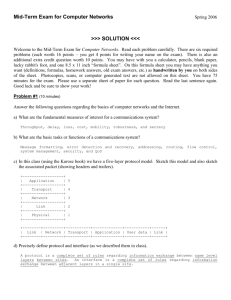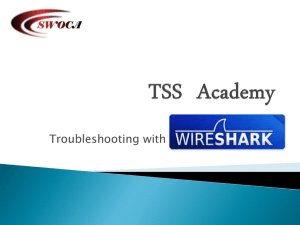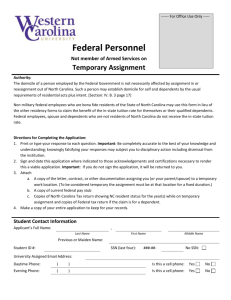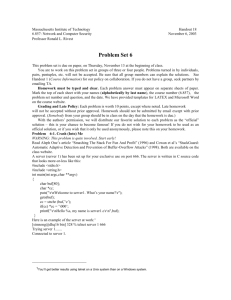Comprehensive Final Exam for Computer Networks >>> SOLUTIONS
advertisement
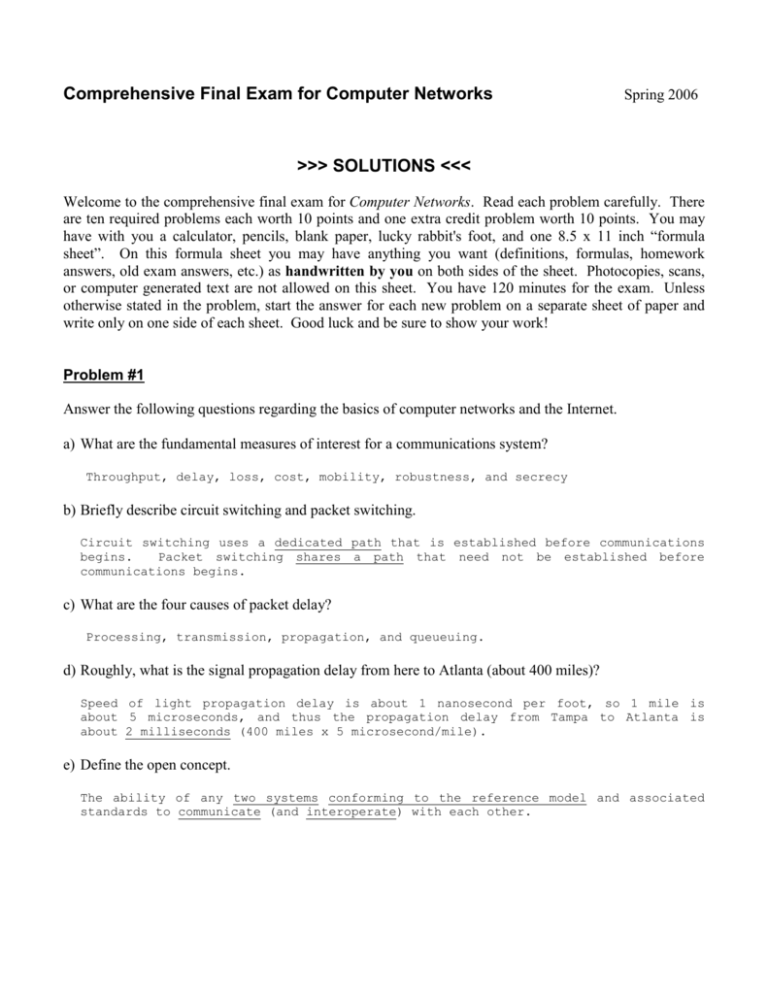
Comprehensive Final Exam for Computer Networks
Spring 2006
>>> SOLUTIONS <<<
Welcome to the comprehensive final exam for Computer Networks. Read each problem carefully. There
are ten required problems each worth 10 points and one extra credit problem worth 10 points. You may
have with you a calculator, pencils, blank paper, lucky rabbit's foot, and one 8.5 x 11 inch “formula
sheet”. On this formula sheet you may have anything you want (definitions, formulas, homework
answers, old exam answers, etc.) as handwritten by you on both sides of the sheet. Photocopies, scans,
or computer generated text are not allowed on this sheet. You have 120 minutes for the exam. Unless
otherwise stated in the problem, start the answer for each new problem on a separate sheet of paper and
write only on one side of each sheet. Good luck and be sure to show your work!
Problem #1
Answer the following questions regarding the basics of computer networks and the Internet.
a) What are the fundamental measures of interest for a communications system?
Throughput, delay, loss, cost, mobility, robustness, and secrecy
b) Briefly describe circuit switching and packet switching.
Circuit switching uses a dedicated path that is established before communications
begins.
Packet switching shares a path that need not be established before
communications begins.
c) What are the four causes of packet delay?
Processing, transmission, propagation, and queueuing.
d) Roughly, what is the signal propagation delay from here to Atlanta (about 400 miles)?
Speed of light propagation delay is about 1 nanosecond per foot, so 1 mile is
about 5 microseconds, and thus the propagation delay from Tampa to Atlanta is
about 2 milliseconds (400 miles x 5 microsecond/mile).
e) Define the open concept.
The ability of any two systems conforming to the reference model and associated
standards to communicate (and interoperate) with each other.
Problem #2
Describe how email works. Describe the key components and flows. Identify key standards that apply.
Use figures as needed. About 150 words should be sufficient.
Email is an asynchronous communications medium based on sent and received text
messages (may include non-text attachments). The three major components of email
are user agents, mail servers, and the SMTP (Simple Mail Transfer Protocol). SMTP
is used to transfer messages between mail servers using TCP/IP (client/server).
SMTP uses ASCII commands and headers. Commands are not authenticated. Between a
mail server and a user agent, POP (Post Office Protocol), IMAP (Internet Mail
Access Protocol), or HTTP (HyperText Transfer Protocol) is used to access received
mail stored in inboxes on the mail server. Mail servers have a fixed IP address
and are always powered-on. The user agents need not always be powered-on and also
need not be fixed in location or IP address.
The figure shows a user agent
accessing a mail server with POP, two mail servers exchanging messages using SMTP,
and another user agent accessing its mail server using IMAP.
user agent
server
server
user agent
+-----+
POP
+-----+ SMTP
+-----+
IMAP +-----+
|
|---------|
|---------|
|---------|
|
|
|
|
|
|
|
|
|
+-----+
+-----+
+-----+
+-----+
|-------------------------------|
The Internet
Problem #3
Attached are server.c and client.c with some “bugs”. Identify the bugs and explain how to fix
them.
Server program:
• Missing welcome_s = socket() after line 25
• Missing htons() in line 28
• Missing bind() after line 29
• Listen must have more than 0 connections in line 31
• Missing addr_len assignment after line 32
• Missing +1 for strlen for \0 in line 38
• Should recv() on connect_s in line 38
• Should send() on connect_s in line 38
• Missing closesocket() of welcome_s after line 42
Client program:
• Type of server_addr should be struct sickaddr_in in line 18
• Size of out_buf and in_buf is too small in lines 19 and 20
• Should be SOCK_STREAM and not DATAGRAM in line 24
• Missing htons() in line 28
• Missing +1 for strlen for \0 in line 36
Problem #4
Derive the formula for link utilization (U) for the stop-and-wait protocol. You may assume that a sender
always has packets to send and that packets are never lost or in error. If other assumptions are needed to
complete a reasonable derivation, state them.
We know U = t_useful / (t_useful + t_overhead).
t_pr
For SAW protocol we have the following time
components, t_fr for data frame transmission,
t_pr for propagation, t_proc for processing,
and t_ack for ack frame transmission. We have:
data
t_fr
t_proc
ack
t_ack
t_useful = t_fr
t_pr
t_proc
t_overhead = 2t_pr + 2t_proc + t_ack.
Thus U = t_fr / (t_fr + 2t_pr +2t_proc + t_ack).
Problem #5
Answer the following questions about TCP:
a) Describe how TCP sets its retransmission time-out (RTO) value.
The ideal RTO value would be the exact RTT for the current packet sent. TCP uses
an algorithm to estimate the RTT value. The algorithm uses exponential smoothing
(alpha is the smoothing parameter) to generate an SRTT (smoothed RTT) as a
function of the last measured RTT sample and past history as SRTT(k+1) =
alpha*SRTT(k) + (1 – alpha)*RTT_sample(k+1). RTO(k+1) is then beta*SRTT(k+1). A
more recent algorithm also estimates the variability in RTT and uses this
variability estimate to add a value to SRTT(k+1) instead of just multiplying it by
a fixed beta.
b) Show the packet flows for TCP connection establishment and termination.
Establish
Terminate
SYN
FIN
SYN-ACK
ACK
ACK
FIN
ACK
Problem #6
Below are the first 60 bytes of a TCP/IP packet captured using Ethereal on an Ethernet network. On the
last pages of this exam are packet header templates. Decode the packet for the following fields:
- Ethernet MAC source and destination addresses (hexadecimal)
- IP source and destination addresses (in standard dotted-decimal format)
- TCP source and destination port numbers (decimal)
- Type of TCP segment (e.g., SYN, FIN, ACK, etc.)
- Application layer protocol (and command, if applicable)
08
02
03
ff
73
6d
00
4b
01
ff
74
6c
20
1f
08
80
65
20
f7
f8
68
d7
6e
48
88
40
00
00
2f
54
MAC source
MAC dest
IP source
IP dest
TCP source port
TCP dest port
TCP type
Application
7d
00
50
00
63
54
=
=
=
=
=
=
=
=
00
80
e0
47
68
50
11
06
5a
45
72
2f
43
ca
79
54
69
31
b7
9b
da
20
73
2e
92
83
38
2f
74
31
43
f7
0b
7e
65
0d
08
03
ef
63
6e
0a
00
2a
53
68
2e
48
45
83
50
72
68
6f
00
f7
18
69
74
73
.. ..}..C..C..E.
.K..@........*..
...h.P.Zy.8..SP.
......GET /~chri
sten/christen.ht
ml HTTP/1.1..Hos
080020f7887d hex
001143b79243 hex
131.247.3.42
131.247.3.1
2152
80
PUSH, ACK
HTTP (this is an HTTP 1.1 GET)
Problem #7
Answer the following questions about LANs (wired and wireless):
a) What is a LAN? Define it precisely.
A LAN is a data network optimized for a medium-sized area (10s to 100s of stations
and 100s to 1000s of meters).
A LAN is owned and operated by a single
organization.
b) Describe CSMA/CD and BEB as used in IEEE 802.3 Ethernet.
CSMA/CD is Carrier Sense Multiple Access / Collision Detection and enables the
sharing of a wired medium among multiple hosts. A 1-persistent CSMA algorithm is
implemented as follows (for when a host has a frame to transmit):
1) if medium is idle then transmit
2) if medium is busy then wait for medium to go idle and then transmit
3) if detect a collision then xmit a brief jam signal, stop transmitting,
wait a random period of time, then (1)
The "wait a random period of time" is implemented with Binary Exponential Backoff:
while (attempts < 16)
k = min(attempts, 10)
r = rand(0, 2^k)
delay = r * slot_time
A slot_time is the time it takes to transmit 64 bytes. This time determines the
maximum span of an Ethernet (i.e., tpr <= tfr for frame of 64 bytes and tpr being
the end-to-end propagation time).
c) Describe CSMA/CA as used in IEEE 802.11 WiFi.
CSMA/CA is Collision Avoidance and has both a sender and receiver component.
sender algorithm is:
The
1) if sense channel idle for DIFS then transmit entire frame
2) if sense channel busy then
start random backoff time
timer count down while channel is idle
transmit when timer expires
if no ack, increase random backoff interval and repeat (2)
The receiver algorithm is:
1) if frame received then return ACK after SIFS
DIFS is distributed interframe time and SIFS is short interframe time.
longer than SIFS.
DIFS is
Problem #8
Answer the following questions bridges and switches:
a) What is a bridge? What is a switch? What are the motivations to use bridges and switches?
A bridge is a 2-port layer-2 packet filter.
A bridge forwards only non-local
frames.
A bridge has no knowledge of upper layer protocols.
A switch is a
multiport bridge.
Motivations to uses bridges and switches include increasing
performance (by localizing traffic), improving reliability (over a single large
LAN), and defining organizational boundaries.
b) Describe (give) the forwarding and learning algorithm for transparent bridges.
receive a frame
if (DA is in table) and (DA is local) then
not forward
else
forward
if (SA in table) then check/update direction
if (SA not in table) then add to table
c) What is “media speed” or “wire speed” (in packets per second) for 1500 byte packets on a 1 Gb/s
Ethernet link.
10^9 bits/sec / ((1500 + 8 + 12) bytes/frame * 8 bits/byte) = 82345 frames/sec
Problem #9
IEEE 802.11 WiFi uses three address fields in its frame format to forward packets from a host in a hotspot
to the Internet and from the Internet to a host in a hotspot. Assume that a WiFi access point (AP) is
connected to a router port via an Ethernet link. Describe the packet flow from WiFi host to Internet and
from Internet to WiFi host. Carefully identify the contents of all WiFi and Ethernet addresses fields.
From host to AP to router port:
Host to AP: WiFi frame has addr1 = AP MAC, addr2 = host MAC, addr3 = router MAC
AP to router: Ethernet frame has DA = router MAC and SA = host MAC
From router port to AP to host:
Router to AP: Ethernet frame has DA = host MAC, SA = router MAC
AP to host: WiFi frame has addr1 = host MAC, addr2 =AP MAC, addr3 = router MAC
Problem #10
Answer the following questions about multimedia networking and security:
a) What is a jitter buffer? How does it work? Why is it needed?
A jitter buffer is a FIFO queue in a receiving host where prefetched video (or
audio) data is played-out. The playout rate is the same as the sender rate. The
amount of pre-fetched data is such that it can tolerate delay variability in the
network without starving (running out of data).
A jitter buffer is needed to
guarantee a needed constant playout rate (i.e., the same constant rate as at the
sender) to the decoder in the receiver.
b) If we were to design a next generation network that would give QoS guarantees, what are the four basic
principles (or pillars) needed for this network?
The four pillars are packet classification, isolation, call admission, and high
utilization.
c) What are the three desirable properties of secure communications? Describe each property in one
sentence.
The
three
properties
are
confidentiality,
authentication,
and
integrity.
Confidentiality is that only sender and receiver should be able to understand the
message transmitted.
Authentication is to confirm or prove the identity of the
sender or receiver in the communication.
Integrity assures that the message
transmitted is not altered maliciously or by accident to achieve non-repudiation.
Extra Credit
Give 40 networking-related acronyms (covered in this class, or in the textbook) and define them. For
example, TCP = Transmission Control Protocol is good. MCSE = Microsoft Certified Systems
Engineering is not good (we did not cover this topic or acronym in class).
No specific solution.
related to networking.
To be graded individually.
Key is that the acronym is
1.
2.
3.
4.
//======================================================= file = server.c =====
//= A message "server" program to demonstrate sockets programming
=
//=
- TCP/IP client/server model is implemented
=
//=============================================================================
5.
6.
7.
8.
//----- Include files --------------------------------------------------------#include <stdio.h>
// Needed for printf()
#include <string.h>
// Needed for memcpy() and strcpy()
#include <windows.h>
// Needed for all Winsock stuff
9.
10.
//----- Defines --------------------------------------------------------------#define PORT_NUM
1050
// Arbitrary port number for the server
11.
12.
13.
14.
15.
16.
17.
18.
19.
20.
21.
22.
23.
//===== Main program ==========================================================
void main(void)
{
WORD wVersionRequested = MAKEWORD(1,1);
// Stuff for WSA functions
WSADATA wsaData;
// Stuff for WSA functions
unsigned int
welcome_s;
// Welcome socket descriptor
struct sockaddr_in
server_addr;
// Server Internet address
unsigned int
connect_s;
// Connection socket descriptor
struct sockaddr_in
client_addr;
// Client Internet address
struct in_addr
client_ip_addr; // Client IP address
int
addr_len;
// Internet address length
char
out_buf[100];
// Output buffer for data
char
in_buf[100];
// Input buffer for data
24.
25.
// This stuff initializes winsock
WSAStartup(wVersionRequested, &wsaData);
26.
27.
28.
29.
// Fill-in server (my) address information and bind the welcome socket
server_addr.sin_family = AF_INET;
server_addr.sin_port = PORT_NUM;
server_addr.sin_addr.s_addr = htonl(INADDR_ANY);
30.
31.
// Listen on welcome socket for a connection
listen(welcome_s, 0);
32.
33.
// Accept a connection.
connect_s = accept(welcome_s, (struct sockaddr *)&client_addr, &addr_len);
34.
35.
// Print an informational message that accept completed
printf("Accept completed \n”);
36.
37.
38.
// Send to the client using the connect socket
strcpy(out_buf, "Test message from server to client");
send(welcome_s, out_buf, strlen(out_buf), 0);
39.
40.
41.
// Receive from the client using the connect socket
recv(welcome_s, in_buf, sizeof(in_buf), 0);
printf("Received from client... data = '%s' \n", in_buf);
42.
43.
44.
45.
// Close sockets and clean-up
closesocket(connect_s);
WSACleanup();
}
1.
2.
3.
4.
//======================================================= file = client.c =====
//= A message "client" program to demonstrate sockets programming
=
//=
- TCP/IP client/server model is implemented
=
//=============================================================================
5.
6.
7.
8.
//----- Include files --------------------------------------------------------#include <stdio.h>
// Needed for printf()
#include <string.h>
// Needed for memcpy() and strcpy()
#include <windows.h>
// Needed for all Winsock stuff
9.
10.
11.
//----- Defines --------------------------------------------------------------#define PORT_NUM
1050
// Port number used at the server
#define IP_ADDR
"127.0.0.1" // IP address of server (*** HARDWIRED ***)
12.
13.
14.
15.
16.
17.
18.
19.
20.
//===== Main program ==========================================================
void main(void)
{
WORD wVersionRequested = MAKEWORD(1,1);
// Stuff for WSA functions
WSADATA wsaData;
// Stuff for WSA functions
unsigned int
client_s;
// Client socket descriptor
double
server_addr;
// Server Internet address
char
out_buf[10];
// Output buffer for data
char
in_buf[10];
// Input buffer for data
21.
22.
// This stuff initializes winsock
WSAStartup(wVersionRequested, &wsaData);
23.
24.
// Create a client socket
client_s = socket(AF_INET, DATAGRAM, 0);
25.
26.
27.
28.
29.
30.
// Fill-in the server's address information and do a connect with the
// listening server
server_addr.sin_family = AF_INET;
server_addr.sin_port = PORT_NUM;
server_addr.sin_addr.s_addr = inet_addr(IP_ADDR);
connect(client_s, (struct sockaddr *)&server_addr, sizeof(server_addr));
31.
32.
33.
// Receive from the server using the client socket
recv(client_s, in_buf, sizeof(in_buf), 0);
printf("Received from server... data = '%s' \n", in_buf);
34.
35.
36.
// Send to the server using the client socket
strcpy(out_buf, "Test message from client to server");
send(client_s, out_buf, strlen(out_buf), 0);
37.
38.
39.
40.
// Close and clean-up
closesocket(client_s);
WSACleanup();
}
NOTE: Ethereal traces do not contain the Preamble or SFD. All LAN addresses are 6 bytes.
From: W. Stevens, TCP/IP Illustrated, Volume 1 The Protocols, Addison-Wesley, Boston, 1994.
